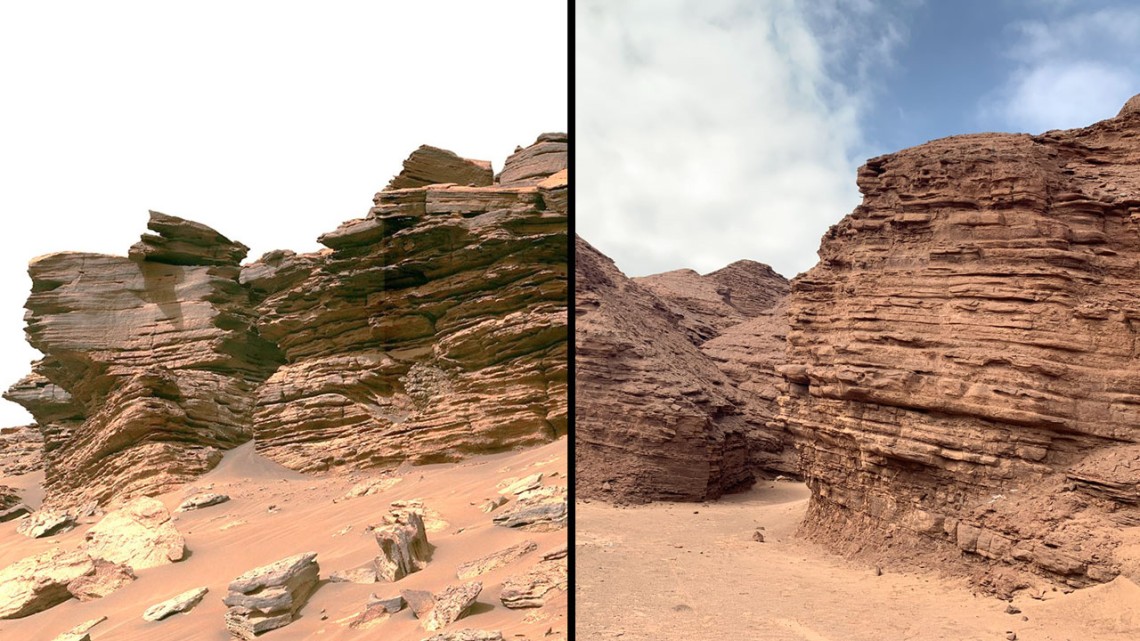The planet Mars is arguably the most extensively studied planetary body in the entire Solar System, which began with telescopic observations by Galileo Galilei in 1609, with such telescopic observations later being taken to the extreme by Percival Lowell in the late 19th century when he reported seeing what he believed were artificial canals made by an advanced intelligent race of Martians. But it wasn’t until the first close up image of Mars taken by NASA’s Mariner 4 in 1965 that we saw the Red Planet for what it really was: a cold and dead world with no water and no signs of life, whatsoever.
Despite this, we kept studying this intriguing world by sending more orbiters, landers, and rovers to search for life on Mars, with each mission becoming more technologically advanced and challenging. These missions currently include NASA’s Curiosity and Perseverance rovers and China’s Zhurong rover, though it’s been reported that Zhurong hasn’t moved in months. However, despite all our searching, we still haven’t found life on Mars. But, why?
This very question is why an international team of researchers led by the Center of Astrobiology (CAB) in Spain have recently examined how current robotic instruments being used on Mars to search for past life might not be sufficient to get the job done, and that samples returned to Earth from the Red Planet might be a better option in identifying signs of present or past life there.
The research team, which includes co-author Dr. Alberto G. Fairén, who is a visiting scientist in the Department of Astronomy at Cornell University and a research professor at CAB, claim detecting organic materials within Martian rocks using current instruments and methods on Mars could prove to be difficult, if not impossible.
For the study, the researchers used four instruments that are either presently being used on Mars, or will be in the future, to examine sedimentary rocks from the Red Stone Jurassic fossil delta in the Atacama Desert of northwestern Chile, which is an alluvial fan that is approximately 100 to 163 million years old that formed under very dry conditions with little to no rain. Along with the dry conditions, Red Stone also contains large amounts of hematite and mudstones comprised of clays, which makes both characteristics geologically comparable to Mars.
While the team was successful in identifying a biosignature combination of present and past microorganisms, they found these microorganisms were rather difficult to detect despite the team’s state-of-the-art laboratory equipment. The team also identified what they referred to as “dark microbiome”, which are microorganisms whose classification cannot be determined.
These findings indicate that the instruments being sent to Mars, both now and in the future, might not possess the sensitivity to detect biosignatures, which would also depend on a combination of the instrument being used and the organic compound being searched for. More precisely, “the chance of obtaining false negatives in the search for life on Mars highlights the need for more powerful tools,” said Dr. Armando Azua-Bustos, who is a research scientist on Dr. Fairén’s team at CAB, and lead author of the study.

The researchers noted two options in the study: sending better instruments to Mars or examining samples returned from the Red Planet “to conclusively address whether life ever existed on Mars,” the researchers note in the study. Dr. Fairén says both options are extremely difficult.
“You need to decide whether is more advantageous having limited capability for analysis on the surface of Mars to interrogate a wide variety of samples or having limited samples to be analyzed with the wide variety of state-of-the-art instrumentation on Earth,” said Dr. Fairén.
Analyzing samples on Earth would require a sample return mission from Mars, which is currently being spearheaded by NASA and the European Space Agency, with the samples being slowly collected and dropped around the Martian surface by NASA’s Perseverance rover.
One such future mission that Dr. Fairén mentions is the first European Mars rover, Rosalind Franklin, previously known as the ExoMars rover, which is currently scheduled to launch as soon as 2028, and had one of its instruments used in this study.
Rosalind Franklin “will carry a drill with the unprecedented capability of reaching down to a depth of 2 meters (6 ½ feet) to analyze sediments better protected against the harsh conditions on the Martian surface,” Dr. Fairén said. “If biosignatures are better preserved at depth, which we expect, there will be more abundance and diversity, and better preservation of biosignatures, in those deep samples. Our instruments in the rover will therefore have more chances to detect them.”
Has Mars ever had life, or has it always been a barren and dead world? Will we be able to develop the appropriate instruments to find life there directly, or will we have to find it within samples returned to Earth? Only time will tell, and this is why we science!
As always, keep doing science & keep looking up!

